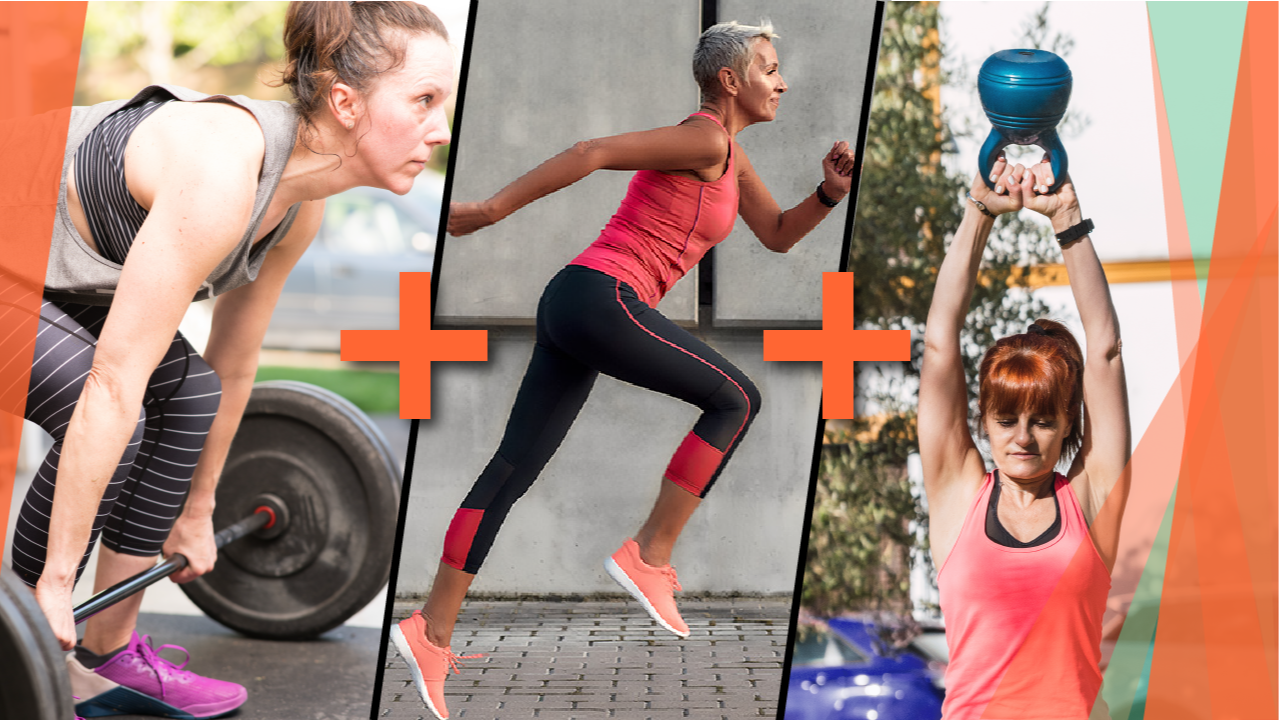How to Power Your Way Through Menopause
May 12, 2022
Heavy lifting. Sprint training. Plyometrics. They all have one thing in common—they’re essential for menopausal health and performance.
Society has taught women to devalue their power. That’s especially true during menopause when we’re told it’s time to slow down and are pointed to the cultural sidelines. Thankfully, that’s changing now that everyone from Oprah to Abby Wambach are putting menopause in the spotlight and trying to create an empowering culture. My goal is to also help women maintain their actual physical power on the playing field, whatever that may be. That means turning down the volume and turning up the intensity.
To be clear, power is different from strength. Strength is your ability to exert force to overcome resistance, like lifting a barbell off a rack. Power includes speed; it’s the force you can generate in a short amount of time. Both are important. But if you want to keep kicking ass as you age, power is key.
In fact, a meta-analysis released earlier this week compared traditional strength training (lifting relatively slowly) with power training (lifting with speed) and found that power training may be superior for improving physical function in healthy older adults. That makes sense because, as the researchers note, power fades more rapidly than strength as we age. And the ability to react and exert force quickly is going to be more helpful for preventing falls and improving function than strength alone.
How Menopausal Women Can Improve Power
In my book (and literally now in my actual book, Next Level) there are three pillars of training that are essential for power: heavy lifting (so you maximize your strength); plyometrics (training your muscles to detonate on-demand explosively), and sprint interval training (applying that strength to speed). Each of them is especially good for women in the menopausal transition and beyond.
Lifting Heavy Sh*t.
During menopause we lose the strength-building stimulus from estrogen. Estrogen is essential for regulating satellite cell function in females; it helps us regenerate muscle stem cells (also known as satellite cells, because they appear to orbit the muscle fiber cells), which help us maintain our muscles. When scientists take estrogen from animals in the lab, their ability to regenerate these cells drops by up to 60 percent. The same is true in women during menopause–estrogen levels are linked to the number of satellite cells. Resistance training is the best way to generate those muscle-making cells, and lifting heavy provides the strength-building stimulus you need as estrogen declines. Heavy lifting is also good for improving fat-burning metabolism, building bones, and maintaining your cardiovascular health.
Aim for 3 to 5 sets of 6 or fewer reps with full rest (i.e. 2 to 5 minutes) between sets. Form is everything. You should be able to complete every rep with good form. When you can't, you're done. Heavy lifting is best done on “big lifts” like deadlifts, squats, lunges, and other Olympic lifts that spread the force out among your major muscles, connective tissues, and joints.
Plyometrics
Whether you jump, hop, or bound, plyometrics gives your bones and muscles the extra stimulus that comes when you push off against gravity and land back down. It is those impacts—big or small—that generate important physiological changes. For one, they help build bone, which we lose during the menopause transition. Plyometrics also trigger epigenetic changes, or changes in your genes. When you do plyometrics, you wake up some otherwise very quiet genes inside your muscle cells that stimulate those cells to improve power and even the composition of the muscle itself in a way that improves the integrity of the muscle, its contractile strength, and its response and reaction time. They also improve your mitochondria function and insulin sensitivity—both of which are important for menopausal women.
You can start with a simple squat jump: stand with feet wider than shoulder-width, feet turned out a little. Extend your arms straight in front of you. Squat down, extending your arms behind you, until your butt drops below knee level. Quickly extend your legs and jump into the air. Land softly, immediately dropping into another squat. Repeat 8 to 10 times. Start with one set. Work up to two.
Sprint Interval Training
If you want to maintain your top end, you need to train your top end. That’s especially true during the menopause transition. The best type of high-intensity interval training for menopausal women is super short, sharp sprint-style intervals lasting about 30 seconds or less. When you extend intervals past 60 seconds, you can get greater increases in the stress hormone cortisol. Cortisol is good for a surge of energy, but you don’t want those stress-hormone levels to stay elevated longer than necessary to get the job done, especially in menopause when cortisol can already be elevated. With sprint intervals, you still get the benefits–improved insulin sensitivity, stronger mitochondria, improved fat burning (especially deep visceral fat), and an ever-important boost of growth hormone after you finish! "Finishers" are a simple way to add intensity to any exercise: After a warm-up, push as hard as possible for 20-30 seconds. Recover for minimum 2 minutes; you want to recover so that the next interval can be just as hard, if not harder, than the first ("full gas!"). Work your way up to a maximum of 5, 30second sprints.


